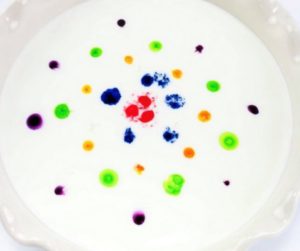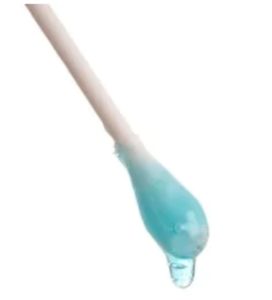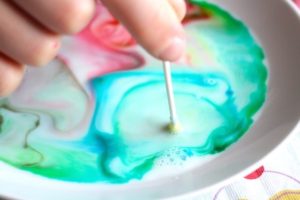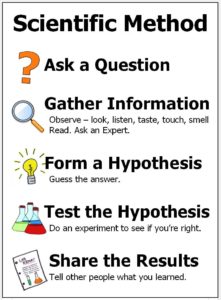This incredibly simple science experiment will mesmerize your child! Using only dish soap, milk, food coloring and a q-tip, your child can learn about chemical reactions. They will set off an explosion of color that keeps changing in waves, right before their eyes. Our students at CEFA Early Learning schools love it!
I guarantee that your child (and you) will love this hands-on experience.
Best Ages for This Activity
One to five
How to Make It
Ingredients
- ¾ cups whole milk (it can work with 1% or 2% but it’s much better with whole milk)
- 3 drops (per colour) of liquid food colouring of various colors (you can try it with just one color, but I really encourage you to do it with at least 4 colours if not more!) any type of food coloring is fine J
- Liquid Dish soap of any kind
- 1 white dinner plate (or similar flat white container)
- 1 q-tip
Let’s Get Started!
- Invite your child to try a science experiment
- Pour the milk in the plate (make sure it completely covers the bottom of the plate) and let the milk settle
- Add a few drops of each color of your food coloring, making sure they don’t touch but put them close together. You can do just a few drops and put them in the centre of the plate, or you can try doing it like this example:

- Soak one end on your q-tip in dish soap

- Ask your child: “What do you think will happen if we dip this soapy q-tip in the milk?” and have your child make a prediction (a hypothesis).
- Invite your child to try it: touch the tip of the cotton swab to the centre of the milk and leave it for 10 to 15 seconds without stirring it. You will be amazed at the beautiful reaction of the colors in the milk! A picture does not do it justice, please try it.

- Did your child predict what was going to happen? What did happen?
- You can try it as many times as you want, each time adding a drop of soap to the q-tip. You can also experiment putting the soapy q-tip in different places in the milk. Notice that the colors in the milk continue to move even when you remove the q-tip.
- Ask your child: “Why do you think the colors are moving? What is happening?”
The Science Behind This Experiment:
Milk is made up of mostly water but it also contains minerals, vitamins, proteins and fat. The fats and proteins react to the soap.
The molecules of fat bend, roll and twist in all directions as the soap molecules race around to join up with the fat molecules. You wouldn’t see this chemical reaction without the food coloring! During all of this fat and soap molecules movement, the food coloring is getting bumped and pushed around, providing an easy way to observe all the invisible activity.
The soap molecules are trying to catch all the fat molecules. When there is no more movement, all the fat molecules have been found. Are there any more hiding? Try another cotton swab dipped in soap and see what you can find!
Learning Opportunities
This is a thrilling S.T.E.M. activity where your child can see a chemical reaction as it happens. For better science learning, follow the steps of your scientific method with your child. Make sure you use as much math vocabulary as you can (for example, name the colors; observe if the movements are fast or slow, or slowing down; see the difference when you add soap near a big drop of food coloring versus a small drop; see if the color touches the edge of the plate or if it stays I the centre; see if it goes to the left or to the right; etc.)

Extended Learning Opportunities
- Try the experiment again, but this time have three plates: one with whole milk, one with 1% milk and one with water. Does the same reaction happen in all three plates? Why?
- Tip: the more fat, the more fat molecules there are to join with the soap molecules, and therefore the bigger the reaction.
- Invite your child to draw their observations.
CEFA tip: Remember to let your child do as much of the process as they are capable of.
Books Your Child Might Like
Toys Your Child Might Like
For 3 year olds and older:
For 5 year olds and older: